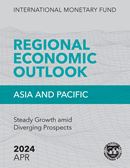This web page presents information about the work of the IMF in Singapore, including the activities of the IMF Resident Representative Office. Additional information can be found on the Singapore and IMF country page, including IMF reports and Executive Board documents that deal with Singapore .
Singapore: At a Glance
- Current IMF membership: 190 countries
- Singapore joined the Fund on August 3, 1966; Article VIII
- Quota: 3891.9 million
- The last Article IV Executive Board Consultation was on August 23, 2023 (Country Report 23/314)
News and Highlights
-
Central Bank Digital Currency: Emerging Good Practices
IMF – Singapore Regional Training Institute 25th Anniversary Celebration Event November 14, 2023, Singapore
November 13, 2023
-
Transcript of the Asia and Pacific Department Press Briefing
Director of the Asia and Pacific Department, Krishna Srinivasan, gave an overview of the latest economic forecast for the region, discussed policy challenges, and answered reporters’ questions.
October 13, 2023
-
Starting in March 2023, the Singapore Seminar Series, jointly organized by the IMF Singapore Regional Training Institute (STI) and the IMF Singapore Resident Representative Office, aims to discuss current developments in the major economies of the region. The seminar brings together experts from the IMF and other organizations in order to deepen and share knowledge through open discourse.
July 13, 2023
-
Singapore’s economy rebounded on decisive policy action, but challenges lie ahead
Op-Ed by Krishna Srinivasan and Lamin Leigh on The Business Times, June 27, 2022
June 27, 2022
-
Pandemic resurgence slows recovery in Asia
Op-Ed by Changyong Rhee on The Edge Singapore, October 21, 2021
October 21, 2021
Singapore and the IMF
-
April 30, 2024
Opening Remarks by Krishna Srinivasan, Director of the Asia and Pacific Department at the press conference on the release of the IMF’s Regional Economic Outlook for Asia and Pacific, April 30, 2024, Singapore
-
Transcript of Press Briefing: Asia Pacific Department Regional Economic Outlook April 2024
April 30, 2024
Good morning, everyone. Thank you for attending the IMF's press briefing on the release of the Regional Economic Outlook for Asia and Pacific. I'm Huong Lan (Pinky) Vu from the Communications Department, and joining me today are two speakers. The gentleman next to me, Krishna Srinivasan, Director of the Asia and Pacific Department, and the gentleman on my far left, Thomas Helbling, Deputy Director of the Asia and Pacific Department.
-
Regional Economic Outlook for Asia and Pacific
April 29, 2024
-
April 25, 2024
Since then, the global economy has shown surprising resilience to successive shocks. As you have seen in our latest World Economic Outlook, we expect global growth to reach 3.1 percent this year. Asia remains the engine of growth—on track to deliver 60 percent of global growth this year. And it is ahead of the curve on taming inflation. Most countries in Asia are expected to reach central bank targets in 2024. But challenges remain. Providing extraordinary support in response to the pandemic and Russia’s war in Ukraine has left governments with fewer resources amid high debt and rising debt servicing costs. At the same time, demand for public spending is growing, including in Asia—which faces aging populations and climate change. And the lowest medium-term global growth prospects in decades mean less tax revenues to pay for it all.
-
Building a Fair and Inclusive Tax System in Asia
April 25, 2024
Opening Remarks by Deputy Managing Director Okamura at the Thirteenth IMF-Japan High-Level Tax Conference for Asian Countries, Tokyo, Japan, April 25, 2024
Regional Economic Outlook for Asia and Pacific
April 29, 2024

Growth in Asia and the Pacific outperformed expectations in late 2023, reaching 5.0 percent for the year. Inflation has continued to decline, albeit at varying speeds: some economies are still seeing sustained price pressures, while others are facing deflationary risks.In 2024, growth is projected to slow modestly to 4.5 percent. Near-term risks are now broadly balanced, as global disinflation and the prospect of monetary easing have increased the likelihood of a soft landing. Spillovers from a deeper property sector correction in China remain an important risk, however, while geoeconomic fragmentation clouds medium-term prospects. Given the diverse inflation landscape, central bank policies need to calibrate policies carefully to domestic needs. Fiscal consolidation should accelerate to contain debt burdens and debt service cost, in order to preserve budgetary space for addressing structural challenges, including population aging and climate change.
Read the Report



